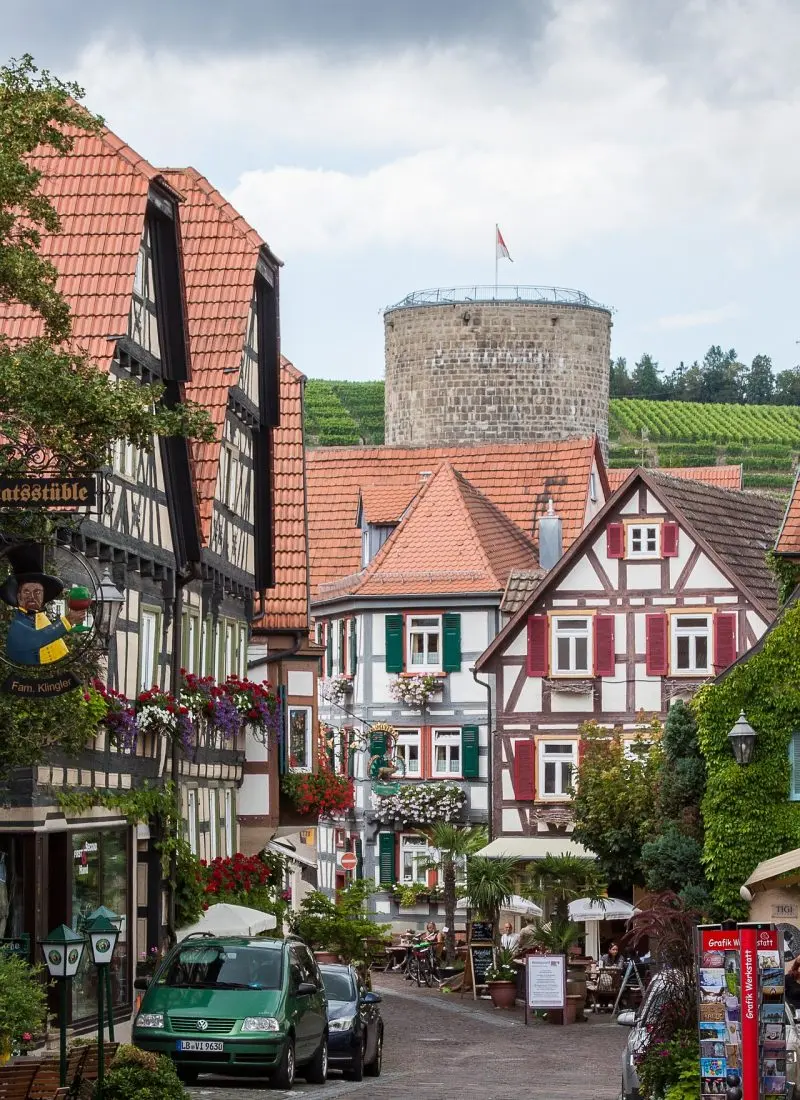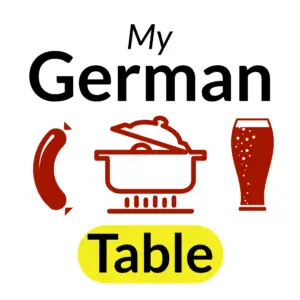The recipes on this blog are mostly from Swabia, a region in Southern Germany. Yet many people, even in Germany, often mistakenly call the inhabitants of the modern-day state Baden-Württemberg Swabians. However, a Swabian state in modern-day Germany doesn’t exist.
The majority of the Swabian population lives in Württemberg and the western part of Bavaria. There is no clear definition of what defines a Swabian. Most commonly, people that have grown up in Swabia and that speak Swabian are considered to be Swabians.
The Duchy of Swabia (Herzogtum Schwaben) was one of the five stem duchies of the medieval German kingdom that existed from 915 until 1313. Even though the Duchy of Swabia doesn’t exist anymore, the name Swabia is still in use today.
The Duchy of Swabia was much larger than modern-day Swabia. It included Baden, the Alsace, and large parts of Switzerland. In the map below, you can see a map of the Duchy of Swabia in the 11th century. The orange area is the Duchy of Swabia. The green area is Upper Burgundy which was an independent kingdom at that time.

The German kingdom between 919 to 1125 was larger than present-day Germany. Besides the Duchy of Swabia, the other four stem duchies of Germany were Bavaria, Franconia, Lotharingia (Lorraine), and Saxony.

The collapse of the Duchy of Swabia
But let’s get back to Swabia. The reason Swabia is so much smaller nowadays than it used to be is that the Duchy of Swabia collapsed in the thirteenth century. The last monarch to govern the Duchy of Swabia was Duke Johann who had to flee from Swabia after he had killed his uncle, Albert I of Habsburg, who was King of Germany from 1282 until his assassination in 1298.
Duke Johann didn’t have any children so that there was no successor to govern the Duchy of Swabia. Another influential family, the Württemberg family, gained control over large parts of Swabia. However, Upper Swabia fell into the hands of Austria. This area of Swabia became a part of the state Further Austria.
Some parts of Swabia remained parts of Austria until 1805 which explains why there are a lot of similarities between Swabian and Austrian cuisine. This also explains why there are still so many Catholics in the Southern parts of Swabia. Every region that was part of Austria or Bavaria was Catholic whereas the Kingdom of Württemberg was a Lutheran territory.
But what about Baden, the territory to the West of Württemberg? In Baden, they proudly claim to not be Swabians. And that is true if you look at the region today. However, as much as some people there don’t like to admit it: people from Baden are of Swabian descent.

In the Duchy of Swabia, there was a royal family called “Baden”. This family was a descendent of the Swabian House of Zähringen. And with the ongoing collapse of the Duchy of Swabia, the Margraviate of Baden was established in 1112. The people living there wanted to have their own identity so that they left their Swabian roots behind them and defined themselves as Baden people.
The unification of Baden and Württemberg
After World War II, there was a public vote on the future of the German states Baden and Württemberg. As a result, Baden and Würrtemberg were united into the present-day German state Baden-Württemberg. However, that doesn’t mean that Baden-Württemberg is the state of the Swabians.
Baden has been separated from Württemberg for almost 1000 years. And to call Baden people Swabians nowadays is a little disrespectful. They have developed their own identity and they want to keep it as well.
Second, Swabians are the majority in Württemberg but there are also non-Swabian parts in Württemberg like, for example, Heilbronn-Franconia. Not all Franconian people live in Bavaria. Some also live in Württemberg, Hesse, and Thuringia.

To make it short: the German states are very arbitrary and there is no Swabian state. A lot of Northern Germans like to call anyone from Baden-Württemberg Swabian. But this is very wrong. That’s like calling all the people in Bavaria Bavarians.
The reason that many Germans know so little about Swabia
There’s surprisingly very little knowledge and understanding about the German tribes among the German population. That is because of the obsession of the school system with the Holocaust and Third Reich. While these are important topics, they are so overrepresented that things related to local history get rarely taught in school.
They don’t teach the history of Southern Germany here. Thus many Germans don’t know anything about their country except that it took part in two World Wars and failed miserably. Because of that, it is a challenging task for many to accurately draw the present-day Swabian territories into a map of Germany.

The modern-day nation of Germany is a construct of many different tribes and heritages. To end this discussion, I have a small anecdote for you to show how important it is to always consider Germany’s diverse cultural heritage.
A few years ago, the boss of the IHK – Chamber of Commerce and Industry – in Augsburg proposed to rename the Swabian parts of Bavaria into West Bavaria. Of course, this guy was from Northern Germany. He claimed that the name “West Bavaria” would be less confusing for foreigners and that many people think of Stuttgart rather than Augsburg when they hear the word “Swabia”.
Needless to say, he didn’t have any success with this proposal. The Swabians were offended because the area has never been a part of old Bavaria. Adding to that, the Bavarian prime minister at that time, Horst Seehofer, stated that Swabia has always been Swabia. Swabia will never be Bavaria. In the end, it was a huge embarrassment for the boss of the IHK.
So please, never ever make the mistake to equate the modern-day German states with any of the old German tribes. Baden-Württemberg is not the “Schwabenland” (Swabian state) as many people from Northern Germany claim. The terms Württemberg and Swabia are no synonyms.
Resources:
Geschichte des Herzogtums Schwaben
Grand Duchy of Baden – From a splinter state to a model country






After reading an fascinating novel about witchcraft in 15th century Germany, I posed this exact question to my uncle, a lawyer, but also expert on the history of Central Europe. It turned out to be a hard question to answer, as he consulted various books from his library. Here I was, expecting him to point it out on the map. Well, now I see why this was not a simple question!
Here’s the book – highly recommended: https://www.goodreads.com/book/show/4705891-highroad-to-the-stake
Thanks for the book recommendation and your financial support, Michael!
Europe has always been a very dynamic continent. In my eyes, it has lost a lot of diversity with the uprise of modern-day nation-states. In Germany, we established the Northern accent as the standard language and worked on becoming one nation. A unique and shared identity was needed for this so that the indivdiual regions lost a lot of their traditions and things that were unique about them. The Swiss are proud of being a multilingual and multiethnic state. They chose the opposite way of Germany and Italy. Nowadays many Germans don’t think local anymore. They say “I am German” rather than “I am Swabian”. Our goverment still dreams that we will, in the near future, just say: “I am European.” But I, and the majority of Europeans, are very opposed to creating one European nation-state with one shared identity and language. The big loosers of that would be all the minorities and our diverse heritage.
For example, the Alsace and Lorraine region was for most of its history a region where German and French people lived peacefully together. Then after World War II, the French decided that they needed to impose a French national identity on the people living there. A lot of people there had German as a first language but then it was made mandatory for all schools to be fully in French (the Alsace people have traditionally been very critical of Paris and the French government). Nowadays, the region is as French as any other part of France. That’s needed to stabilize and secure the nation-state France but I’m also not a fan of forcefully creating one national identity. But I guess it’s not unique to Europe. In China the same thing is happening to Tibet and the Uyghur. Erdogan is doing the same thing in Turkey. I hope that we will embrace multicultural and multilingual states rather than oppose them as being unstable and unharmonic in the future. Modern-day nation-states are huge and not all people inhabiting the area should be forced to share one universal culture or language.
Thank you! I’ve been trying to figure out my family history and I just couldn’t wrap my head around the concept of Swabia. No wonder it was impossible to discover whether my ancestors were Swabian based solely on where they were born. This helps a lot, mostly because I don’t feel so dumb.
Thanks for your comment, Carolyn!
I’m happy to hear you enjoyed the article and learned something new about your ancestry. – Tim
Is the term “Swabia” etymologically related to the ancient Germanic tribe called “Suevi” by the Romans?
Yes the Roman word for Swabia is Suevia. Suevia and Swabia are the same.